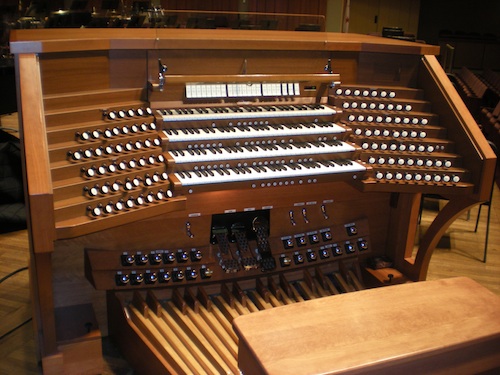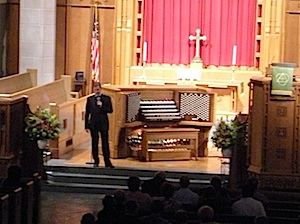Arts & Entertainment
Dynamic differences
Two brand new organs — two of the world’s best organists — four days in Washington
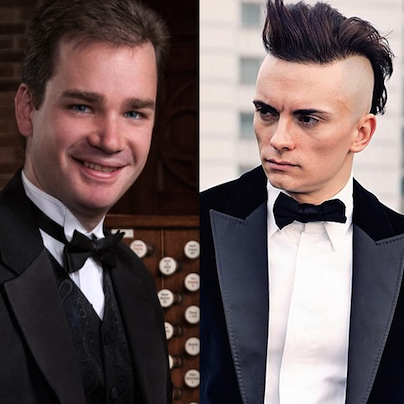
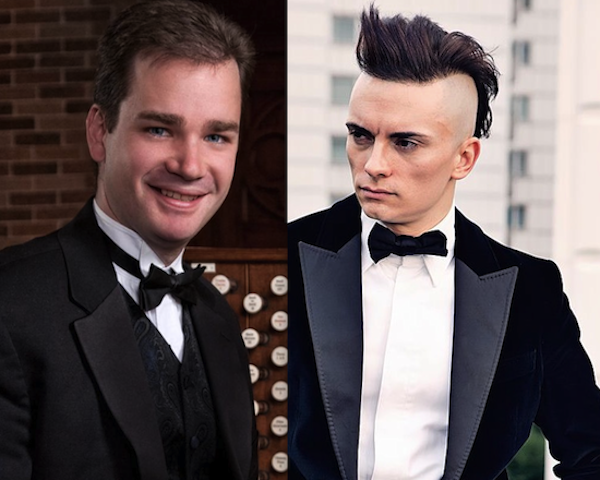
Ken Cowan, left, and Cameron Carpenter. (Cowan photo by Jim Cunningham, courtesy First Baptist Church; Carpenter photo by Heiko Laschitzki, courtesy Bucklesweet Media)
Pipe organ aficionados in Washington had the opportunity to gorge on an embarrassment of riches over the past few days. On Wednesday, iconoclast Cameron Carpenter played the Kennedy Center. Just four days later, traditionalist Ken Cowan performed at D.C.’s First Baptist Church.
The rare experience of having these two brilliant young organists here so close together was doubled by the fact that both venues in which they played just unveiled massive new organs.
The Rubenstein Family Organ at the Kennedy Center, a $2 million, 85-rank, four manual beauty by Casavant Freres, has 4,972 pipes and replaces the Filene Organ, an Aeolian Skinner from 1972 that was adequate at best. It’s a gift from Kennedy Center chairman David Rubenstein and his wife, Alice.
The new Austin organ at First Baptist is a 118-rank double (chancel and gallery) organ that has about 6,000 pipes and cost roughly $1.8 million. It’s only the second five-manual (i.e. five levels of keyboards) organ in Washington (National City Christian Church — which added to the wealth by hosting the equally good organist Adam Brakel just the week before — has the other) and replaces the church’s woefully underwhelming previous instrument, a relic Moller from 1948 that had just two manuals and about 2,100 pipes.
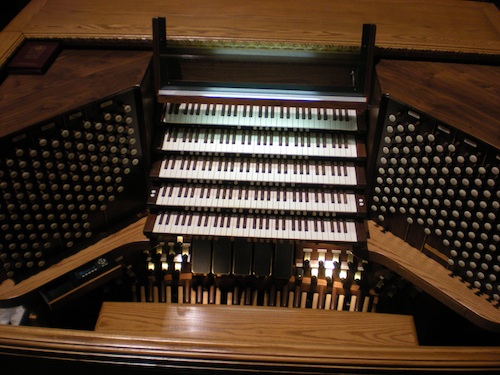
The new Austin Organ (Op. 2795) at First Baptist Church of Washington. (Blade photo by Joey DiGuglielmo)
The Rubenstein is a full pipe organ; First Baptist’s is majority pipe but is augmented with some digital stops. They’re not the largest organs in Washington — National Cathedral’s 1938 Skinner has 189 ranks and more than 10,647 pipes and the National Shrine’s two Moller organs have a combined 197 ranks and 10,748 pipes; National City’s has 105 ranks and nearly 7,600 pipes. Yet these are still major new additions to the District’s musical landscape. More pipes don’t necessarily mean more sound — just a larger range of tonal variation that’s available.
While both instruments have been previously heard, Carpenter’s program was the first “concert length” recital on the new organ at the Kennedy Center and opens a series that continues with Paul Jacobs — one of a very short list of young organists in the same league as Carpenter and Cowan — on Feb. 5 and Latvian organist Iveta Apkalna on May 21. Despite the Rubenstein organ only having been played publicly a handful of times thus far, it was Carpenter’s second time playing it. He played the fourth movement of Saint-Saens’s “Symphony No. 3 in C minor” (the “organ symphony”) on it with the National Symphony Orchestra on Sept. 29.
And while First Baptist organist/choirmaster Lawrence Schreiber gave the inaugural recital of the Austin organ on Sept. 15, Cowan’s performance this week was the first in the church’s “Distinguished Organist” series, which continues with a performance by Christopher Houlihan on Nov. 24. An hour-long recital featuring several guest players of the region will be held on Halloween at 7 p.m.
The two concerts — equally dazzling — were a study in contrasts, chiefly because of the vast difference of artistic and aesthetic choices from Carpenter, 32, and Cowan, 38. Both played fully from memory save for one short self-composed piece for which Carpenter used a score. Possessed, it appears, of equal talent, Carpenter is a colorful rabble rouser who clearly delights in shaking up the often staid world of organ music. One could never call Cowan staid — he simply lights his musical fires with a different brand of kerosene. His playing is every bit as technically impressive and boundary-pushing as Carpenter’s; he just does it while wearing a tux and in a setting — First Baptist — as traditional (albeit breathtaking) as it gets.
One may be momentarily intrigued by their differences — Cowan’s tux and everyman’s haircut to Carpenter’s Versace, tight leather pants and mohawk, the former’s straight sexual orientation (he’s married to violinist Lisa Shihoten) to the latter’s bisexuality, etc. — and insist only the sounds produced are of consequence, but it’s not that simple, for they’re each having a radically different impact on the world.
Since they’re of roughly equal ability, one quickly realizes there are other factors at play, some musical, some not, just as there were with the late organists Virgil Fox and E. Power Biggs a generation ago. What’s ironic is how the organ world establishment (represented mostly in the U.S. by the American Guild of Organists) now venerates Fox while Biggs is but a footnote. Though Carpenter is often dismissive and indifferent when asked about Fox, it’s always the envelope pushers who are remembered long after their time. It’s amusing to watch these perceptions play out — many U.S. organists, both in church and in academia, are almost contemptuous of Carpenter and only grudgingly acknowledge his technical prowess while Cowan is exalted as one of a precious few heirs apparent.
This isn’t just about hairstyles or even registrations (the settings by which organ sounds are varied throughout a piece or concert), for Cowan’s, while overall less brash than Carpenter’s, are not always as slavishly adhered to as some traditionalists insist (e.g. using only registrations that Bach had at his disposal in the 1700s when playing his works today).
Controversial, outspoken Carpenter is clearly having the overall bigger impact. Touted as “the world’s most visible organist” in the Kennedy Center program, it’s not much of an overstatement if at all. Though his D.C.-area debut at the Strathmore in April had an underwhelming turnout, he filled the orchestra section easily at the 2,400-seat Kennedy Center Concert Hall (the upper tiers were empty). Yes, the tickets were only $15 a piece, but a nearly full house to any organ recital in 2013 is seen as a triumph even if it’s free. Which Cowan’s was, though donations were accepted. The floor of First Baptist, which seats about 800, appeared to be about half full Sunday.
Carpenter’s at times brutal candor equals that of Joni Mitchell. Think for a minute about the overall rigidity of the classical world versus the pop world, and one can imagine the effect this has. Just last week, Carpenter mentioned in passing organ conventions and lamented anyone “unfortunate enough to have to go to one.” The AGO brass sees these as cheap shots and holds grudges accordingly. They’re sharpening their knives now in anticipation of his 2014 unveiling of a Marshall & Ogletree digital touring organ whose development Carpenter — who’s always polite in conversation and more nerdy than punk — supervised. He says it will revolutionize what an organist can do by not forcing an adaptation to site-specific pipe organs. They say there’s no way a virtual instrument can duplicate the richness of a true pipe organ (while Fox toured with electronic organs in the 1970s he never — to my knowledge — claimed they were sonically in the same league as a pipe organ).
There also may be unacknowledged resentment of the amount of world-wide press attention Carpenter gets, which is considerable, perhaps even unprecedented, for an organist. His fame is of rock star proportions in Japan and in parts of Europe.
Marketing and presentation are also factors. Carpenter has more media savvy, more acumen at presenting himself as a celebrity. Cowan — more classically handsome than Carpenter but not as trim and buff — looks like a professor (which he is; he heads the organ program at Rice University) who just happens to give recitals on weekends (which he does). Place their latest albums side by side and the photos alone illustrate the difference. Carpenter makes wise use of a stylist and put care into the overall presentations. 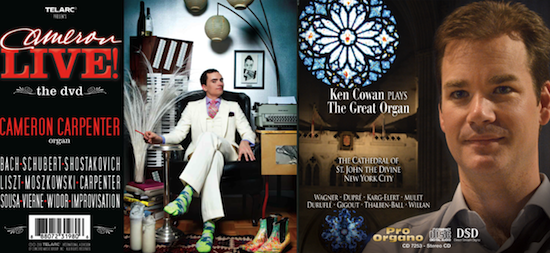 Cowan’s looks like an improperly lit snapshot superimposed over a boring church interior. Star power counts for something and Carpenter has it. It’s the difference between, say, a Jane Fonda and a Liv Ullmann. It’s no fluke that Fonda is the household name.
Cowan’s looks like an improperly lit snapshot superimposed over a boring church interior. Star power counts for something and Carpenter has it. It’s the difference between, say, a Jane Fonda and a Liv Ullmann. It’s no fluke that Fonda is the household name.
It was a bit startling then — with all this swirling around the classical music consciousness — how traditionally Carpenter opened his 89-minute Kennedy Center recital with the Bach “trio” Sonata No. 6 in G Major (BWV 530), especially the exquisite first movement (“Vivace”) which sounds as dainty as a finely embroidered doily but is wickedly difficult to play with three contrapuntal lines swirling about (right hand on one manual, left hand another and the pedals/feet sharing an equally complex third voice). Carpenter took it at a very brisk tempo and pulled it off with expected aplomb. He used more pedal 16-foot stops than Bach would have had in his era, but the flute- and principle-heavy registration was not unorthodox. His closing self-added ornamentation — not an unusual thing to do — was a well-placed flourish at the end of a musical sentence.
The registrations were slightly more daring in the languid second movement (“Lento”), which had breathy, deep 16-foot moderately soft pedal stops over which Carpenter wove the melody with slightly louder reed stops. He took the (“Allegro”) third movement in a more traditional manner, giving its lovely contrapuntal interplay the stately feel of a fanfare.
One of the challenges any organist faces is blending the four types of sounds the instrument produces — generally the flutes and strings are softer than the principles and reeds. Building a gradual increase in volume by changing registration can be tough, but Carpenter did so brilliantly (Cowan is also a master of this) in his Etude from the prelude of Bach’s “Cello Suite No. 1,” a piece he also used as an encore in homage to Yo-Yo Ma (who also played that night) during his previous Kennedy Center appearance. It started with a delicate, chiffy pedal solo but climaxed with loud grandiosity.
Its inclusion was a surprise — Carpenter added it after saying he wasn’t finished learning his new composition “Music for an Imaginary Film” which was slated to close the program. In its place he also added his own “Love Song No. 2,” a lush, string-laden contemporary piece he rightly called a palate cleanser.
He closed the first half of the program with an adaptation of Mozart’s “Sonata in D Major” (K.284), which had constant-yet-deft color shifts. He made clever use of some of the organ’s more outré stops with playful little honks and echoes in the third movement, several of which elicited light chuckles from the crowd.
In the second half, Dupre’s “Variations on a Noel, Op. 20” came roaring to life in a way simply not possible when Carpenter performed the piece (one of only two duplicated) at the Strathmore. It was effective there, but if it were possible to hear the two performances side by side, no further arguments would be needed for the sonic chasm that exists between a grand instrument like the Rubenstein organ and the one-dimensional Rodgers electronic Carpenter played there. He performed like a demon that night — changing registrations like a mad scientist (perhaps necessitated by the need for variation on the much smaller organ) — but hearing him at the Kennedy Center was exponentially more satisfying. The Dupre Noel set is a perfect piece for Carpenter giving him enough deliciously weird variations (most of it’s about as warm and Christmasy as a Quentin Tarantino film) to play with. He upped the ante with equally diabolical registration choices, at times summoning what sounded like the gates of hell with the full power of the organ.
If there was any disappointment to the evening, it was only slightly in the sequencing. Building an impossibly overstated introduction to a transcription of Scriabin’s (originally for piano) “Sonata No. 4, Op. 30,” (“I can’t imagine music more uplifting and absolutely affirming of humanity than this,” he said), the piece (originally slated to close the first half) was too dense and abstract to be a wholly satisfying finish to the evening. The heroic, playful and jaunty Tchaikovsky “Scherzo” from “Symphony No. 6,” which Carpenter practically galloped his way through — you can see the music coursing through his gyrations — and used to open the second half, would have been a better choice. Yes, it’s the more ear-friendly and obvious crowd pleasing-kind-of piece, but that’s not why I suggest this. The epic full organ registration with which Carpenter played it sounded so rich and symphonic, one could not possibly fathom that all this sound was coming from one human and one organ. Closing with it would have showed both he and the organ off in the most staggering light.
Two encores — Chopin’s “Minute Waltz” and the bon mot “Stars and Stripes Forever” were everything encores should be: playful, fun, short and easy on the ears.
Cowan, too, opened his 94-minute recital with Bach, hardly surprising but fine. His “Toccata in E Major (BWV 566)” got things off to a solid but far-from-earth-shattering manner. Cowan’s almost non-existent body movement while playing combined with the hardly daring opening — though admittedly no more traditional than Carpenter’s — initially had me fearing we might be in for a long afternoon. I knew Carpenter would shake things up; having not heard Cowan live before, I wasn’t sure where he was heading. Yes, there was a program but the pieces were not, for the most part, staples of the organ repertoire.
To say there was nothing to fear is a vast understatement. Cowan quickly got things bubbling with an utterly transfixing performance of Jean Roger-Ducasse’s “Pastorale,” which he played exquisitely and registered imaginatively and seamlessly.
Ironically considering the sacred setting, the devil was summoned twice — in Rachel Laurin’s playful “Beelzebub’s Laugh,” an etude that Cowan masterfully registered so that a three-note descending melodic line that was repeated many times darted around from the Chancel to the Gallery organs so quickly it was nearly dizzying. Satan was further evoked in an arrangement of Liszt’s famous “Mephisto Waltz No. 1,” a staggerlingly virtuosic piece with which Cowan clearly had fun.
Leo Sowerby’s maddeningly difficult “Pageant,” which opens with a lengthy pedal solo that descends in rapid chromatic lines, found Cowan exhibiting every bit as much elaborate foot work as Carpenter famously exhibits in his transcription of Chopin’s “Revolutionary Etude,” a massive YouTube hit he curiously no longer plays live. While nobody’s calling it a talent competition, the two are clearly equals in technical ability and overall musicianship.
Cowan’s recital came to a glorious and stately climax with Max Reger’s monumental Fantasy on the Chorale “Wachet auf, ruft uns die stimme,” (Op. 52, No. 2), a dramatic interpretation of the famous Advent hymn (“Sleepers Awake”) that breaks into a daring four-part fugue and ends with a towering procession on which Cowan brought the magnificent new organ to full flower. This is another spot that separates the men (state-of-the-art pipe organs) from the boys (the best electronics available): the triple-forte passages on a great organ like the Austin are unquestionably loud but not in an ear-splitting, siren kind-of way. It’s loud in a lush way that still manages to be easy on the ear and with a depth of quality and detail no speaker can summon — nearly the same difference as one perceives optically between a sunset in nature versus one seen on a high definition TV screen. Only having experienced it in nature, can one fully appreciate the difference.
Cowan’s well-deserved encore was another pedal workout — George Thalben-Ball’s “Variations on a Theme by Paganini,” which found him achieving almost unfathomable legato-yet-uber-fast melodic passages on the pedalboard alone.
As one might imagine, these recitals together made for heady experiences. One savored them as one might great multi-course meals from two top-tier chefs working with the crème de la crème of fresh ingredients on two different nights. It’s impossible to overstate their sumptuousness. No degree of rhapsodic waxing feels sufficient.
First Baptist’s organ — some tuning issues evident at Schreiber’s recital all worked out as expected — is not necessarily sonically any richer than that of the Rubenstein organ; it simply has a substantially broader range of sound, which Cowan made abundant use of and of which Carpenter no doubt would have done as well had he performed there. First Baptist’s fills the space perhaps a bit more thoroughly than the Rubenstein, which, though possessing sonic heft, never quite flirts with rumbling the architecture. You don’t quite feel it the way you feel the enveloping Austin.
It was especially noticeable on the Reger during which Cowan spent lengthy measures savoring the organ’s soft 32-foot pedal stops, which rumbled and chiffed — slightly differently even from tone to tone — like warm signals from beneath the ocean floor. Elsewhere, soft string stops in the manuals sounded as warm as finely ground spun sugar. The two magnificent sets of “trompette-en-chamade” stops (one rank softer and in the English trumpet tradition; the other more blaring and French) were repeatedly woven into the selections and used generously but wisely, ringing out from the church balcony where they’re placed.
Perhaps realizing they both had rare opportunities to introduce many to new instruments, Carpenter and Cowan both clearly took delight in showcasing both their own talent and that of the organ builders.
One salivates at the thought of what these two geniuses will do in the coming years, not to mention all the great organists Washingtonians and visitors will enjoy on these stupendous new instruments.
Blade Features Editor Joey DiGuglielmo may be reached at [email protected].
Carpenter’s set list
Sonata No. 6 in G Major (BWV 530) (Bach)
1. Vivace
2. Lento
3. Allegro
4. Etude on the Prelude from Cello Suite No. 1 in G Major (BWV 1007) (Bach)
5. Love Song No. 2 (Carpenter)
Sonata in D Major (K. 284) (Mozart)
6. Allegro
7. Rondo and Polonaise
8. Theme with Variations
Intermission
9. Scherzo from Symphony No. 6 “Pathetique” (Tchaikovsky)
10. Variations on a Noel (Op. 20) (Dupre)
Sonata No. 4 (Op. 30) (Scriabin)
11. Andante
12. Prestissimo Volando
Encores
13. Minute Waltz (Chopin)
14. Stars and Stripes Forever (Sousa)Cowan’s set list:
1. Toccata in E Major (BWV 566) (Bach)
2. Pastorale (Roger-Ducasse)
3. Beelzebub’s Laugh (Etude-Caprice, Op. 66) (Laurin)
4. Pageant (Sowerby)
Intermission
5. Mephisto Waltz No. 1 (Liszt)
6. Fantasy on the chorale “Wachet auf, ruft uns die stimme” (Op. 52, No. 2) (Reger)
Encore
7. Variations on a Theme by Paganini: a Study for the Pedals (Thalben-Ball)
Theater
Jessica Phillips shines in ‘Penelope,’ a ‘pandemic parable’
Alex Bechtel was inspired to write about loneliness, waiting, separation
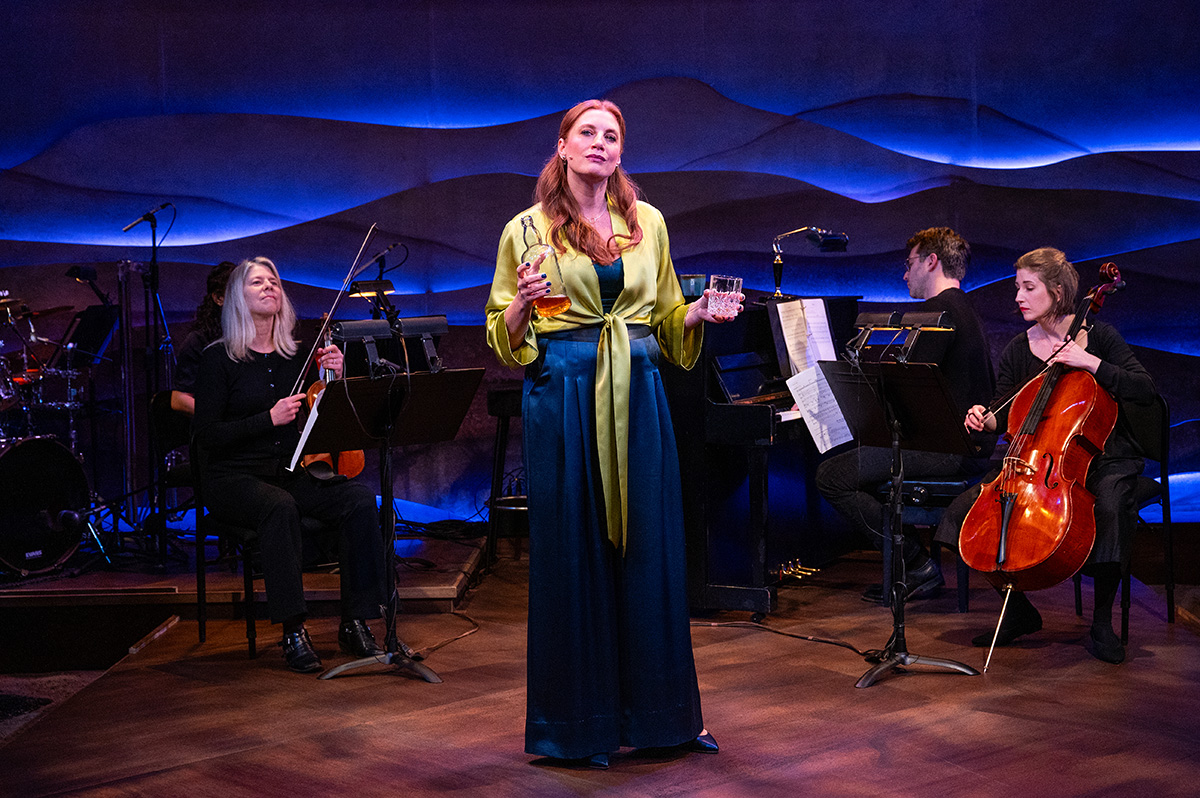
‘Penelope’
Thorough April 28
Signature Theatre, the Ark
4200 Campbell Ave, Arlington
$40-$99
Sigtheatre.org
In the new musical “Penelope,” Broadway’s Jessica Phillips gives an unforgettable take on the title role torn from the pages of Homer’s “Odyssey” — more or less. Fortified by bourbon and backed by a Greek chorus of musicians, the character uncharacteristically steps out from the background to share her story surrounding two decades waiting on the island kingdom of Ithica for the return of her absent husband Odysseus.
Sometimes described as a “pandemic parable,” the 70-minute work is based on composer/playwright Alex Bechtel’s personal experience. While separated from his partner during COVID, he was inspired to write about loneliness, waiting, and separation, a subject Phillips was eager to tackle.
An accomplished Broadway actor and mother of two, Phillips, 52, is best known for memorable turns in “Dear Evan Hansen,” “The Scarlet Pimpernel,” “Next to Normal,” and “Priscilla Queen of the Desert.”
Two years ago, she made news for coming out as queer after having long been identified as straight. Parts of the theater scene were caught a bit off guard, but only momentarily. Now, she lives in New York with her partner Chelsea Nachman, a theatrical publicist.“We share the same professional community but in very different roles. I think that makes life easier for us.”
Currently enjoying an extended run at Signature in Arlington where the trees are in bloom, she spares time for a phone interview, starting off with“Perfect timing. I’ve just finished the last song on Beyonce’s ‘Cowboy Carter.’ Let’s talk.”
WASHINGTON BLADE: Increasingly, I hear artists report having been deeply changed by the pandemic. Did that have anything to do with your coming out in 2022?
PHILLIPS: Definitely. During the pandemic, those of us in the arts were in deep crisis, because our industry had collapsed in almost every way. At the same time, that space allowed us to be contemplative about where we were. For me, that period of time gave me the space to both come to terms with and confront those fears about saying who I was, out loud and publicly.
BLADE: Did you have professional concerns?
PHILLIPS: Oh yeah, I was specifically worried about perception. Not so much about being queer but more what it meant to have come out relatively late in life. I had some fear around whether people would take me less seriously.
At the same time, I was nervous about being fully transparent and worried about my privacy and being vulnerable. Like other women I knew, I was more comfortable dealing with traditional societal expectations in America. I grew up with those cultural expectations and thought of myself in those terms for a long time.
BLADE: What changed?
PHILLIPS: What’s been so freeing for me, I can confront how I took on those expectations and say I’m not going to let those determine how I live my life. I get to decide.
BLADE: There’s a lot of wonderful storytelling in “Penelope.” What’s been your way into that?
PHILLIPS: My way of moving through the show is allowing this character to experience all five stages of grief. Humor, slapstick comedy, bargaining, denial. And ultimately acceptance and deep grief.
When an audience is alive and invested, it’s palpable and elevates the storytelling. When an audience is having a thinking rather feeling experience that changes the tone of my storytelling and not in a bad way.
It’s interesting how much they’re a part of everything. It’s really intimate. The audience is just six feet away. It’s a unique experience and we’re on this ride together. And I find this to be a really beautiful and satisfying experience that I’ve not had before.
BLADE: After Signature, what’s next for “Penelope”?
PHILLIPS: That’s the million-dollar question. Hopefully we’ll take it forward to New York or tour it, but that requires willingness and money. I do think there’s a broad audience for this. It’s beautiful, unique, artistic, really emotional, and at the same time possesses an intellectual quality that’s missing from a lot of commercial theater these days.
BLADE: And what’s next for theater?
Phillips: I think one good thing that came out of the pandemic is that people like Alex Bechtel had an opportunity to create. In the next decade we’re going to see the results of that. I think we have some extraordinary things to look forward to. If a work like “Penelope” is any indication, we’re all in for something really good.
Movies
Trans filmmaker queers comic book genre with ‘People’s Joker’
Alternative ‘Batman’ universe a medium for mythologized autobiography
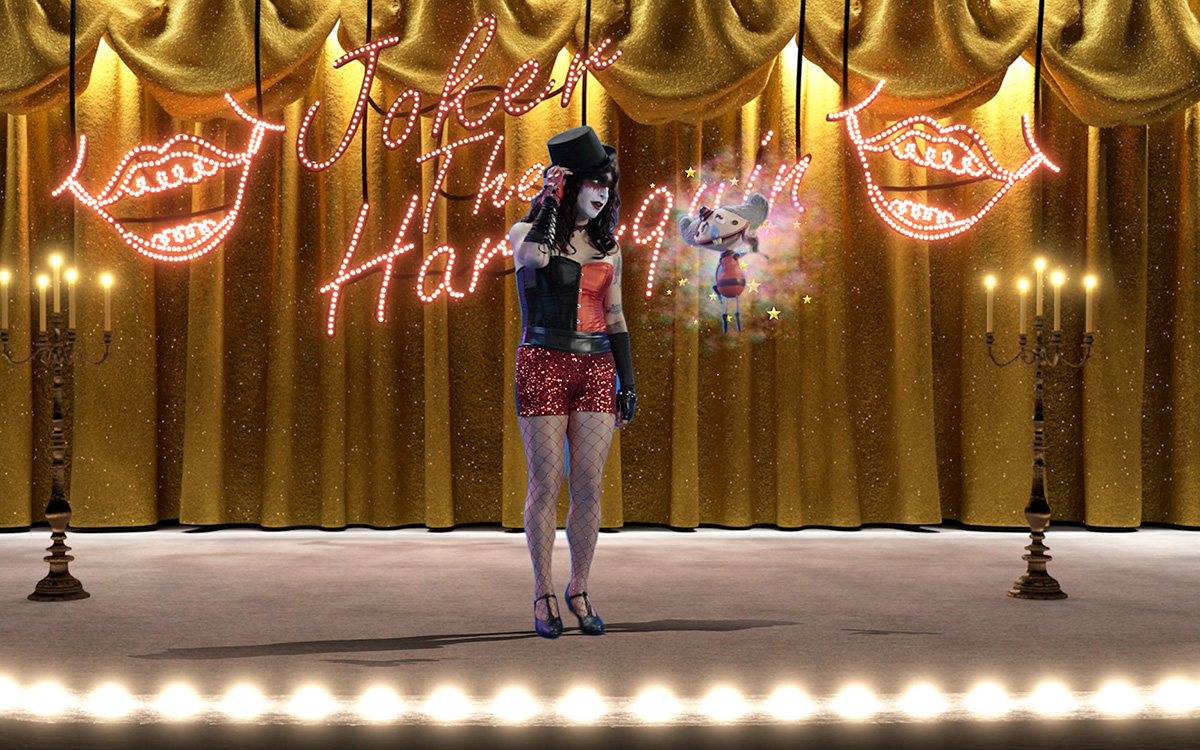
It might come as a shock to some comic book fans, but the idea of super heroes and super villains has always been very queer. Think about it: the dramatic skin-tight costumes, the dual identities and secret lives, the inability to fit in or connect because you are distanced from the “normal” world by your powers – all the standard tropes that define this genre of pop culture myth-making are so rich with obviously queer-coded subtext that it seems ludicrous to think anyone could miss it.
This is not to claim that all superhero stories are really parables about being queer, but, if we’re being honest some of them feel more like it than others; an obvious example is “Batman,” whose domestic life with a teenage boy as his “ward” and close companion has been raising eyebrows since 1940. The campy 1960s TV series did nothing to distance the character from such associations – probably the opposite, in fact – and Warner Brothers’ popular ‘80s-’90s series of film adaptations solidified them even more by ending with gay filmmaker Joel Schumacher’s much-maligned “Batman and Robin,” starring George Clooney and Chris O’Donnell in costumes that highlighted their nipples, which is arguably still the queerest superhero movie ever made.
Or at least it was. That title might now have to be transferred to “The People’s Joker,” which – as it emphatically and repeatedly reminds us – is a parody in no way affiliated with DC’s iconic “Batman” franchise or any of its characters, even though writer, director and star Vera Drew begins it with a dedication to “Mom and Joel Schumacher.” Parody it may be, but that doesn’t keep it from also serving up lots of food for serious thought to chew on between the laughs.
Set in a sort of comics-inspired dystopian meta-America where unsanctioned comedy is illegal, it’s the story of a young, closeted transgender comic (Drew) who leaves her small town home to travel to Gotham City and audition for “GCB” – the official government-produced sketch comedy show. Unfortunately, she’s not a very good comic, and after a rocky start she decides to leave to form a new comedy troupe (labeled “anti-comedy” to skirt legality issues) along with penguin-ish new friend Oswald Cobblepot (Nathan Faustyn). They collect an assortment of misfit would-be comedians to join them, and after branding herself as “Joker the Harlequin,” our protagonist starts to find her groove – but it will take negotiating a relationship with trans “bad boy” Mr. J (Kane Distler), a confrontation with her self-absorbed and transphobic mother (Lynn Downey), and making a choice between playing by the rules or breaking them before she can fully transition into the militant comic activist she was always meant to be.
Told as a wildly whimsical, mixed media narrative that combines live action with a quirky CGI production design and multiple styles of animation (with different animators for each sequence), “People’s Joker” is by no means the kind of big-budget blockbuster we expect from a movie about a superhero — or in this case, supervillain, though the topsy-turvy context of the story more or less reverses that distinction — but it should be obvious from the synopsis above that’s not what Drew was going for, anyway. Instead, the Emmy-nominated former editor uses her loopy vision of an alternative “Batman” universe as the medium for a kind of mythologized autobiography expressing her own real-life journey, both toward embracing her trans identity and forging a maverick career path in an industry that discourages nonconformity, while also spoofing the absurdities of modern culture. Subverting familiar tropes, yet skillfully weaving together multiple threads from the “real” DC Universe she’s appropriated with the detailed savvy of a die-hard fangirl, it’s an accomplishment likely to impress her fellow comic book fans — even if they can’t quite get behind the gender politics or her presentation of Batman himself (an animated version voiced by Phil Braun) as a closeted gay right-wing demagogue and serial sexual abuser.
These elements, of course, are meant to be deliberately provocative. Drew, like her screen alter ego, is a confrontation comic at heart, bent on shaking up the dominant paradigm at every opportunity. Yet although she takes aim at the expected targets – the patriarchy, toxic masculinity, corporate hypocrisy, etc. – she is equally adept at scoring hits against things like draconian ideals of political correctness and weaponized “cancel culture”, which are deployed with extreme prejudice from idealogues on both sides of the ideological divide. This means she might be risking the alienation of an audience which might otherwise be fully in her corner – but it also provides the ring of unbiased personal truth that keeps the movie from sliding into propaganda and elevates it, like “Barbie”, to the level of absurdist allegory.
Because ultimately, of course, the point of “People’s Joker” has little to do with the politics and social constructs it skewers along the way; at its core, it’s about the real human things that resonate with all of us, regardless of gender, sexuality, ideology, or even political parties: the need to feel loved, to feel supported, and most of all, to be fully actualized. That means the real heart of the film beats in the central thread of its troubled connection between mother and daughter, superbly rendered in both Drew and Downey’s performances, and it’s there that Joker is finally able to break free of her own self-imposed restrictions and simply “be” who she is.
Other performances deserve mention, too, such as Faustyn’s weirdly lovable “Penguin” stand-in and Outsider multi-hyphenate artist David Leibe Hart as Ra’s al Ghul – a seminal “Batman” villain here reimagined as a veteran comic that serves as a kind of Obi-Wan Kenobi figure in Joker’s quest. In the end, though, it’s Drew’s show from top to bottom, a showcase for not only her acting skills, which are enhanced by the obvious intelligence (including the emotional kind) she brings to the table, but her considerable talents as a writer, director, and editor.
For some viewers, admittedly, the low-budget vibe of this crowd-funded film might create an obstacle to appreciating the cleverness and artistic vision behind it, though Drew leans into the limitations to find remarkably creative ways to convey what she wants with the means she has at her disposal. Others, obviously, will have bigger problems with it than that. Indeed, the film, which debuted at the 2022 Toronto International Film Festival, was withdrawn from competition there and pulled from additional festival screenings after alleged corporate bullying (presumably from Warner Brothers, which owns the film rights to the Batman franchise) pressured Drew into holding it back. Clearly, concern over blowback from conservative fans – who would likely never see the film anyway – was enough to warrant strong arm techniques from nervous execs. Nevertheless, “The People’s Joker” made its first American appearance at LA’s Outfest in 2023, and is now receiving a rollout theatrical release that started on April 5 in New York, and continues this week in Los Angeles, with Washington DC and other cities to follow on April 12 and beyond.
If you’re in one of the places where it plays, we say it’s more than worth making the effort. If you’re not, never fear. A VOD/streaming release is sure to come soon.
Travel
Hot fun in the desert sun: Your Palm Springs guide
Hiking, dining, bar hopping, and more await

Palm Springs is a favorite destination of mine. I have lots of friends there and there is always something new to do. This trip was no exception. Hiking in two new natural areas. A cabaret shows at Oscar’s. Swimming with the USMS Masters at the Palm Springs Swim Center. A bagel at Townie Bagels and a baguette at Peninsula Pastries. And a cocktail at PSP Air Bar were among the highlights.
WHAT TO DO
Enjoy the Villagefest Thursday night downtown. They block off the street, and it becomes a huge farmers market and art show.
Hit the PS Air Bar for an airline themed evening. They have piano bar Sunday nights in the front. Shop at the Revivals store in the same complex.
Hike in the new Prescott Preserve, formerly a golf course.
Take a hike at the South Lykken Trailhead in Oswit Canyon. Enjoy the cacti and wildflowers. We saw 3 big horn sheep in the meadow. Check out the Oswit Land Trust website for more information.
Go shopping on Sunny Dunes just off South Palm Canyon drive where you will find vintage stores, the Tool Shed leather bar, the new Club 541, antique stores, and a cactus and succulent gift shop (as well as Townie Bagels). Then walk or bike along the new trail along the river just south of Sunny Dunes Road. They even have the plants marked. All are steps from the Motel 6 Downtown.
NIGHTLIFE
Catch a show or go to the Sunday T Dance at Oscar’s. They also have a drag brunch both Saturday and Sunday called “The Bitchiest Brunch.” I saw the fabulous trio, Brandon, and James with Effie, on a Thursday night.
Toucans Tiki Lounge has a popular drag show Monday night. Pick up some new underwear or adult novelty items at the Not So Innocent store next door, 200 N. Palm Canyon.
The Tool Shed at 600 E. Sunny Dunes has a Sunday beer bust and BBQ. They also have an underwear night on Thursdays.
Hunters Palm Springs on Arenas Road has a fun happy hour. (This is the same owner as the one in Wilton Manors, Fla.) You will find 10 other bars nearby.
Fasten your seat belts for the Karaoke Thursday night at PSP Air Bar. The airline themed speakeasy is inside Bouschet. Sit in an old first class American Airlines seat (or an old coach Southwest Airlines seat) while the captain pours you a drink at the PS Air Bar. Then enjoy a show at the Revolution Stage Company next door.
WHERE TO EAT
Grab your morning bagel and coffee at Townie Bagels at 650 East Sunny Dunes. Get there early or expect a line. They open at 6:30 a.m. They are at 650 E. Sunny Dunes Road and have a cult following.
Enjoy a café Americano and pastry at Ristretto For Coffee Lovers (500 S. Palm Canyon Drive).
Enjoy a French baguette or pastry at Peninsula Pastries, 611 S. Palm Canyon in the Sun Plaza. They are only open Thursday to Sunday starting at 8:30 a.m. Get there early to avoid the line. All baked goods use French flour. Like Townie Bagels, they are quite popular. Next door is the Palm Greens Café for a healthy lunch.
Nature’s Health Food and Café (555 Sunrise Way) has fresh juices like carrot juice and vegetarian items like the eggplant wrap. You can sit outside on their patio with your to-go food.
Pick up fruit, yogurt or a pre-made sandwich at Grocery Outlet, Bargain Market in downtown Palm Springs.
GETTING THERE AND GETTING AROUND
I took United through Denver on the way out and through their Houston hub on the way back. United had the best fare and best departure times so I chose them despite my disdain for their policy charging for carry on for basic economy passengers. I had Economy Plus so I got a no charge carry on.
Palm Springs has a cute, small airport with a huge outdoor area. It’s the nicest airport I have ever been to. However, pack something to eat as they have few food options at the moment.
Hop on the #2 SunLine Bus across the street from the airport to go downtown. It’s a two block walk and costs $1. Rental car not needed if you stay downtown. (The lines for the rental cars can be long and they are packed with fees and surcharges.) I used Uber when not taking the SunLine. (SunLine.org)
Leave your bike helmet at home. The city does not have a shared bike system and is not pedestrian friendly outside of the downtown area despite being flat and having a warm climate.
WHERE TO (AND NOT TO) STAY
I stayed at the very handy and very affordable Motel 6 Downtown, 600 S. Palm Canyon. It is across the street from the Sun Plaza, which consists of many shops and restaurant, is a short walk to the bars on Arenas Road, is around the corner from Townie Bagels and the Tool Shed Bar, and more. Rooms are cleaned daily without asking – unheard of with most motels and hotels. The internet is good. No annoying resort fees. Free coffee every morning at 6 a.m. Get a quiet room on the third floor facing east.
Beware of junk fees like resort fees at other Palm Springs hotels. Most hotels in Palm Springs now have them and they are only disclosed on third party booking sites at the end of the reservation process making the room rate look lower than it actually is.
Often, they are lumped under “taxes and fees” to make you think the government requires them. My favorite (not) was the mandatory “community impact fee” at the Hotel Zoso. It is for a mandatory contribution to a charity.
Happily, I have yet to see hotels add a “pillow fee” or “key fee.”
Palm Springs has many lodging options including VRBO and specialty resorts. Men will like the new Twin Palms Resort as well as their sister property, The Descanso Resort. Both are excellent. Service is top notch. Lunch catered everyday. And more.
MORE INFORMATION
GED is the local magazine. RAGE Monthly out of San Diego also covers PS as does the Los Angeles Blade.
The weekly is the Coachella Valley Independent, which covers upcoming events, restaurants, hikes, local politics and more.
Palm Springs also has a gay radio station. Pick up a copy of their KGay desert Guide or view them at kgaypalmsprings.com (106.5 on the FM dial).
You won’t run out of fun things to do in Palm Springs and summer is their value season.
There is nowhere else where you can enjoy the desert sun surrounded to the west and north by snow capped mountains. And you won’t find a gayer city anywhere.
Bill Malcolm is an award-winning travel writer. His syndicated travel column in run by select LGBTQ publications throughout North America. You can find him on Facebook and read his columns at the travel blog section of the IGLTA website. He received no compensation of any kind for this column.
-
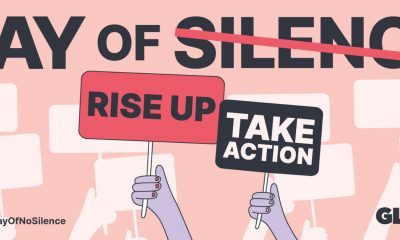
 LGBTQ Non-Profit Organizations5 days ago
LGBTQ Non-Profit Organizations5 days agoDay of [no] silence, a call to speak out against anti-LGBTQ+ hate
-

 Africa1 day ago
Africa1 day agoCongolese lawmaker introduces anti-homosexuality bill
-

 Colorado3 days ago
Colorado3 days agoFive transgender, nonbinary ICE detainees allege mistreatment at Colo. detention center
-

 District of Columbia5 days ago
District of Columbia5 days agoFour LGBTQ candidates running for delegate to Democratic National Convention from D.C.

